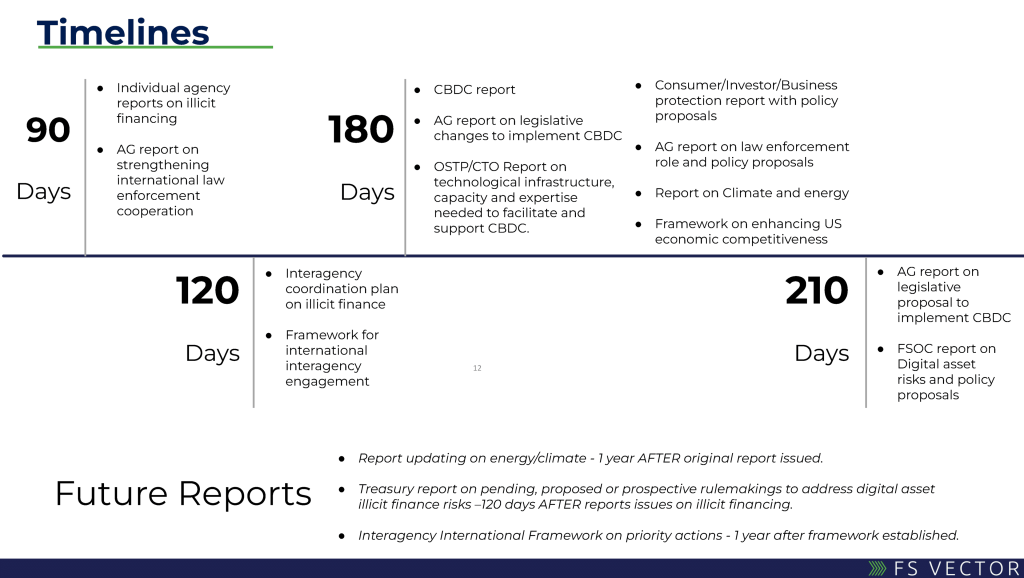President Biden’s Executive Order on Ensuring Responsible Development of Digital Assets (EO) from March 9, 2022, has been widely acknowledged as a watershed moment for the crypto industry. Advocates in D.C. have worked tirelessly for years lobbying those who are both directly and indirectly tied to the White House in order to focus the United States’ highest office on the potential and promise of digital assets. If you know a crypto advocate in Washington, D.C., now is a good time to give them a pat on the back!
In the short time since the EO was issued, policy wonks and pundits have pored over the text to understand its implications for crypto. In a strict sense, the EO did not actually pronounce new policy. Rather, the EO:
- Outlines a number of broad policy objectives
- Orders many of the nation’s highest federal officials to coordinate on digital-asset policy
- Places the highest priority on the development of a U.S. central bank digital currency (CBDC)
- Directs the production of numerous reports on digital assets described in the graphic below (courtesy of FS VECTOR)

Earlier today, I participated in a panel discussion hosted by the Technology Policy Institute to answer the question “What Does the EO Mean for Crypto Policy?” Having worked in technology policy for nearly 20 years, I have examined the EO from a broad perspective, and it is clear to me that the White House has approached other emerging technologies differently. For example, the Clinton administration promoted the development of the early Internet through The Framework for Global Electronic Commerce. That framework was based on private-sector leadership and a hands-off, do-no-harm approach by the government. More recently, the Trump administration outlined a National Strategy for Critical and Emerging Technologies that promoted American leadership in research, technology, invention and innovations by prioritizing emerging technologies with a market-oriented approach.
In contrast to both of those efforts by the White House to promote emerging technologies, the recent EO focuses a great deal more on mitigating risks and potential harms of digital assets than it does on championing innovation. Even the title of the EO gives a strong impression that risks and harms are potentially imminent if continued development on digital assets is not undertaken with the highest degree of responsibility. Above all, the EO calls for “responsible development,” terms that have very rarely been used in the context of tech policy, but are frequently used in policy language to address the appropriate use of natural resources.
The White House, in fact, does not appear to perceive digital assets as a new technology that needs to be promoted and nurtured for the benefit of society. Instead, digital assets are being treated as a somewhat inconvenient and unwelcome technological development. It has grown so rapidly that the White House has no other choice but to formally recognize it, focus the whole of government on controlling it, and co-opt it as a central bank digital currency (CBDC), just as many other countries in the world are also doing. The EO goes into detail about the necessity for the U.S. to lead on the development of a CBDC, but says very little about the need to lead in the development of other cryptocurrencies, decentralized finance (DeFi), or the decentralized web (Web3) – technologies that could fundamentally restructure global finance and Internet services to better incorporate democratic values and promote liberty.
It is truly disappointing that the White House fails to see that cryptocurrencies and their closely related decentralized extensions are still very nascent technologies that need to be encouraged, not burdened with excessive scrutiny and specialized regulation. The unfortunate takeaway is that the White House is reacting to the disruptive power of cryptocurrency the same way a global financial intermediary would react to a serious threat. Going forward, we can expect to see a lot of progress on the development of a U.S. CBDC, but we should expect to see all other areas of cryptocurrency development to be more scrutinized and regulated.
Overall, my biggest concern and disappointment with the EO is that digital assets and cryptocurrencies are not being celebrated as the incredibly important technological advances that they are. In that regard, the EO completely misses the mark. As Zooko has pointed out, money itself is technology, and politically-neutral money is necessary for democratic societies. We need digital cash that is actually like cash. It needs to have privacy and anonymity to be surveillance-resistant and supportive of free expression.
For all of those crypto advocates in D.C. that worked so hard to achieve this milestone of recognition by the White House, do not stop for long to celebrate this moment. The hardest work is just beginning!
